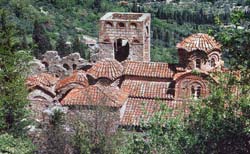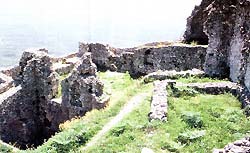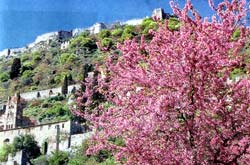
|
Walking Through the Symbol of Byzantium
When exploring the churches and castle of Mystras, one gets a taste of 13th century art and grandeur |
|
By Diane Shugart, Athens News
Thoughts about the links between past and present inevitably float around your mind when visiting Mystras, a 13th-century city where the Byzantium Empire's last ruler, Constantine XI, was crowned in 1448 – roughly ten years before the fall of Constantinople. Its proximity to Sparta, among the most powerful city-states of ancient Greece and longtime rival of Athens, makes for an interesting juxtaposition of cycles of human history. Once the seat of the Morea, as the Peloponnese was called by the Franks, Mystras later became a symbol of Byzantium, luring scholars and artists from throughout the Byzantine Empire. Its significance was such that it was among the first cities to be seized by the Turks and one of the first bastions wrested from Ottoman rule after the Greek independence revolt erupted in 1821. Abandon shortly after the modern Greek state was created, Mystras stood stubbornly on the lower slopes of Mount Taygetos even as its population seeped to the modern towns of Sparta and Neos Mystras. From a slight distance, it seems that the embers of the still-smoking town observed in 1824 by the Rev Charles Swan, a British traveler and author of the Voyage to the Eastern Mediterranean, have only just been extinguished. This odd sensation of a town gasping in the final throes of abandonment is created, oddly enough, by the bustle of work crews engaged in a massive restoration effort of the site, especially the stunning palaces of the Cantacuzinos and paleologos families that sits on the border between the Lower Town and the Upper Town, and a handful of nuns who continue to occupy the Pantanassa Monastery. Guillaume II de Villehardouin was the first among Greece's mediaeval rulers to single out Mystras as the perfect site for a fortified settlement. Most visitors tend to begin their exploration of Mystras from the Lower Town, gradually working their way up to the rather steep hill's summit.
The city sprawled over the slopes outside the castle's walls was built by its Byzantine rulers, which acquired Mystras during the empire's second period – often referred to by scholars as a second "golden age." At the time, the empire's reach extended into North Africa and east to Belarus, Ukraine and Georgia. Later, as Constantinople faltered, Mystras flourished, and its churches are decorated with some of the finest examples of Byzantine frescoes. Having studied the lay of the land, it's best – if you have your own transportation – to return by road to the site's lower entrance for a more intimate exploration of Mystras' buildings. Visitors are usually drawn towards the right to the cathedral, or mitropolis, which is dedicated to Agios Dimitrios, but it makes more sense to begin from the Pantanassa Monastery first, then descend from there through the Monemvasia Gate and Gothic arcade to explore the Lower Town. Pantanassa, dedicated to Our Lady Queen of All, was built in the early 1400s and is the newest church at Mystras. Entering through a narrow, flowerpot-lined courtyard, you will be greeted by cats of varying colors and sizes. The cats are cared for by the nuns, who sell embroideries and hand-painted icons in a tiny gift shop at the far end of the compound. The church is divided by marble columns topped by Corinthian capitals. The barrel vaults are painted with frescoes whose colors are jaunty as those of the flowers outside. The Ascension is appropriately grand but lacks the simple charm of
From Pantanassa it's fun to simply wander the grounds, exploring the ruins of homes and other buildings at will while heading in the general direction of the Bishop's Palace and the cathedral. One of the site's better preserved buildings, it's a good starting place as the cathedral's compound also houses the Archaeological Museum of Mystras. The collection – icons, church relics, marble carvings. Sections of frescoes – is a good introduction into Byzantine art which provided the bridge between antiquity and the Renaissance. Because the subject of all art created in Byzantium was predetermined by the focus on religious expression, artists' personal expression emerged through style, producing art which, in its sum, displayed an amazing depth and sophistication. Even a sample of such limited geographical range as the artists who came to Mytstras displays an outstanding variety of forms, with some pieces incorporating obvious Eastern or Islamic influences and others clearly inspired by Western aesthetic. The Cathedral of Agios Dimitrios is itself quite impressive. A triple-aisled basilica topped by a gallery and multiple cupolas, it is an eclectic mix of architectural styles that is typical of Mystras' churches. Different sections were added over a period spanning the 13th century, when some of the earliest wall paintings have been dated, to the 15th century when the gallery was added. The frescoes illustrate various religious themes, culminating with the Last Judgement in the narthex. A large marble slab laid with the double-headed eagle marks the spot where Byzantine's last emperor was crowned. The slope curves north, drawing visitors further into the Lower Town towards the Church of the Evangelistria (Our Lady of Annunciation) and the Church of Agii Theodorii the oldest church of Mystras. Evangelistria is built in the same domed, cross-in-square style as the Church of Agia Sophia and the Panagia Peribleptos, while Agii Theodorii stands out for its octagonal shape. The site is quite extensive and even though some buildings, such as the Palace of Despots, may be closed to the public because of restoration work, this somehow makes a visit to the site more manageable. It's also a perfect reason for planning more than one visit to Mystras – each one differs depending on the season. Getting there Mystras, on the outskirts of Sparta, is about 230km from Athens via the Athens-Corinth-Kalamata highway. Bus service is available to Sparta (Athens KTEL, tel 210-512-4913), with local KTEL service to Mystras (timetables and fares at 27310-26441) Getting around The only way around Mystras is on foot. The site has two entrances, one about midway up the steep hill, near the Lower Town and one about midway up the steep hill, near the entrance to the Upper Town. The second entrance is also the nearest gate to the "kastro" or ruined castle. Allow at least four hours for the site. Wear comfortable walking shoes and take water, even in the winter. The site is open from 8am to 7pm through October 31, admission 5 euros (reductions apply for students, senior citizens etc) Mystras site and museum, tel 27310-83377 Where to stay Mystras can be visited on a day-trip from Athens, but can also make for a good weekend break. Accommodation is available in Neos Mystras, the town founded in the early 19th century at the foothills of the old Byzantine settlement, as well as in Sparta or, if you prefer the seaside, at Gytheio When to go The worst time to visit Mystras is in the summer because the heat can make the trek quite uncomfortable. Autumn and mild sunny days in winter are excellent for exploring the site; in spring, Mystras is awash with flowers and particularly lovely Bonus Sparta is in the heart of the Peloponnese's olive-producing region, so stock up on olive oil. Learn about traditional methods of olive cultivation and oil production at the Museum of the Olive and Greek Olive Oil (129 Amalias and Othonos St, Sparta, tel 27310-89315)
|
|



